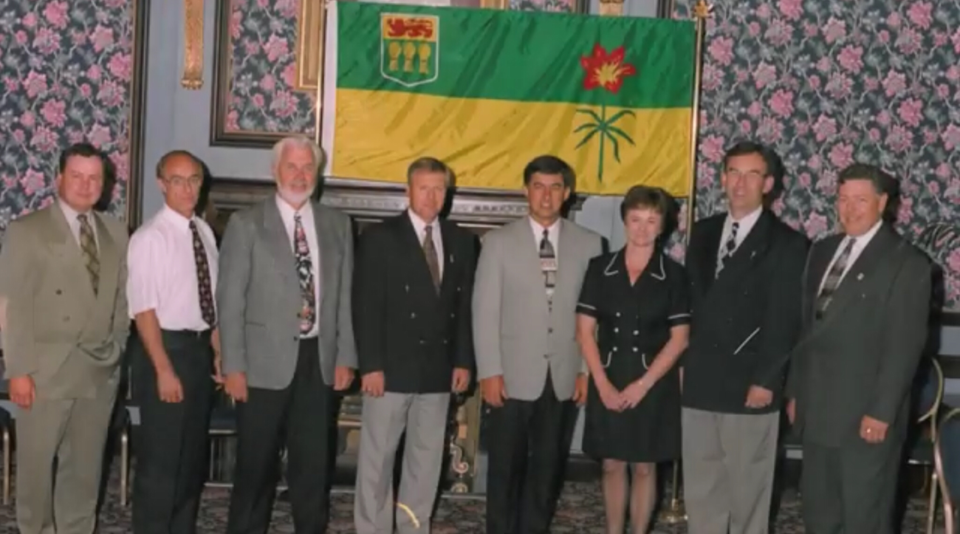DAVIDSON — Aug. 8, 2022 marks the 25th anniversary of a major event in Saskatchewan politics.
It is the anniversary of the date when four former Liberal and four former Progressive Conservative С����Ƶs left their parties to become the new Saskatchewan Party.
The announcement was an earth-shattering moment in the province's political history, one that was celebrated this past weekend by Sask.. Party members.
Sask. Party supporters gathered in Davidson to mark the anniversary. The event on Aug. 6 included Premier Scott Moe as well as party luminaries, and featured a speech from former prime minister Stephen Harper.
The founding of the Sask. Party in 1997 saw the new party made up of former Conservative С����Ƶs Bill Boyd, Dan D'Autremont, Ben Heppner and Don Toth and former Liberal С����Ƶs Bob Bjornerud, June Draude, Rod Gantefoer and Ken Krawetz.
In an interview with the Battlefords News-Optimist in 2018, Gail Krawetz, author of Risk & Reward: The Birth and Meteoric Rise of the Saskatchewan Party, said it was a big risk for the С����Ƶs to form the new party.
“But they decided it was time to move forward. A majority of the people in the province did not want the NDP as government; however, because of vote-splitting, they were continuing to form majority governments.”
Krawetz’s account read like a “cloak and dagger account,” as she put it, “because there was a fair bit of intrigue and secret meetings and spying that went on, and so it is an interesting story.”
She also had recounted it was a challenge for the players involved to keep their plans under wraps until the press conference announcing the new party in 1997. Initially she said it was С����Ƶs June Draude and Bob Bjornerud of the Liberals, and Bill Boyd of the PCs, who started the talks. Her husband Ken Krawetz was the last of the eight to join, mainly because he led the Liberal caucus and was Opposition leader at the time.
But it was a desire to turn around the province that drove the effort, she said. “The biggest concern was we were losing our young people, and our brightest and our future. And so that was a big concern for those С����Ƶs when they formed the party. They wanted to reverse that trend. They wanted Saskatchewan to take its rightful place in this country, and they felt it was an important place.”
It took a while for the party to take power, but the Sask. Party ultimately would win the 2007 election and hold commanding majorities in the legislature, with this year marking the 15th anniversary of the party in power.
The result in 2007, which put Brad Wall in power as premier, ultimately dislodged the New Democrats as the province’s main political force, ending a 16-year rule in power. The NDP has been consigned to the opposition benches ever since.
The fortunes of what was left of the province’s Liberal and Progressive Conservative parties were even more pronounced. Both parties went into a tailspin, ultimately losing all of their С����Ƶ representation in the legislature by 2003.
The new Sask. Party was also seen as a model for other “unite the right” parties that have emerged in Canada afterwards. At the federal level, the Progressive Conservatives and Canadian Alliance came together to form the Conservative Party of Canada in 2004. In Alberta the Progressive Conservatives and Wildrose eventually formed the United Conservative Party.
Here is a look at some of the key dates in the history of the Sask. Party over the past 25 years (credit to the Sask. Party website for much of this information):
Aug. 8, 1997: Former Progressive Conservative leader Bill Boyd and former Liberal Opposition leader Ken Krawetz announced the formation of the Saskatchewan Party.
Aug. 11, 1997: Ken Krawetz is selected interim leader by the caucus.
Sept. 10, 1997: Saskatchewan Party caucus is declared by the speaker as the official Opposition in the legislature.
Sept. 17, 1997: The chief electoral officer of Saskatchewan registers the Saskatchewan Party as an official political party after obtaining the required 2,500 signatures.
Nov. 14, 1997: The Saskatchewan Party holds its founding meeting in Saskatoon.
Dec. 1, 1997: The leadership campaign begins with candidates Elwin Hermanson, Rod Gantefoer and D.F. Yogi Huyghebaert entering the race.
April 20, 1998: Hermanson, a former Reform Party MP, is elected the first leader of the Saskatchewan Party.
Oct. 31, 1998: Saskatchewan Party holds its policy convention.
June 28, 1999: Wayne Elhard wins the Cypress Hills byelection to be the first С����Ƶ to be elected under the Saskatchewan Party banner.
Sept. 16, 1999: The Saskatchewan Party reduces the NDP to a minority government, electing 25 С����Ƶs in the 1999 provincial election.
Nov. 5, 2003: The Saskatchewan Party falls short again in the provincial election capturing 28 seats in the 2003 provincial election.
Feb. 28, 2004: Lyle Stewart is named interim leader of the party following the resignation of Hermanson.
March 15, 2004: Swift Current С����Ƶ Brad Wall is acclaimed as the new leader of the Saskatchewan Party.
Sept. 24, 2006: Martensville С����Ƶ Ben Heppner passes away due to prostate cancer.
Nov. 7, 2007: The Saskatchewan Party wins the 2007 provincial election with 38 seats, to form the first Saskatchewan Party government.
Nov. 21, 2007: Premier Brad Wall and the province’s first Saskatchewan Party government are sworn into office.
Nov. 7, 2011: The Saskatchewan Party led by Premier Wall wins a second majority with 49 of 58 seats and over 64 per cent of the popular vote.
April 4, 2016: The Saskatchewan Party wins a third majority government, winning 51 of 61 seats.
Aug. 10, 2017: Premier Wall announces at the party’s caucus retreat his plans to resign as premier.
Jan. 27, 2018: Scott Moe wins the leadership at the Saskatchewan Party leadership convention in Saskatoon, winning a hotly contested race over Alanna Koch on the fifth ballot.
Oct. 26, 2020: Moe leads the Sask. Party to another majority government win with 48 of 61 seats.


